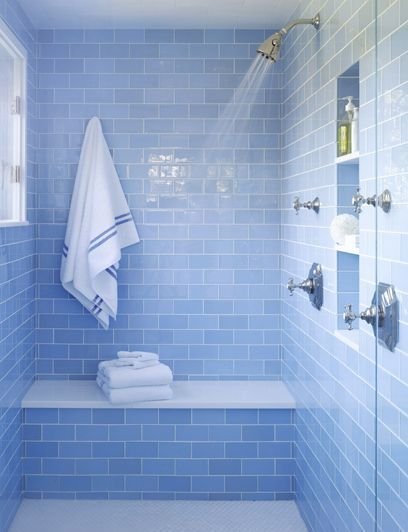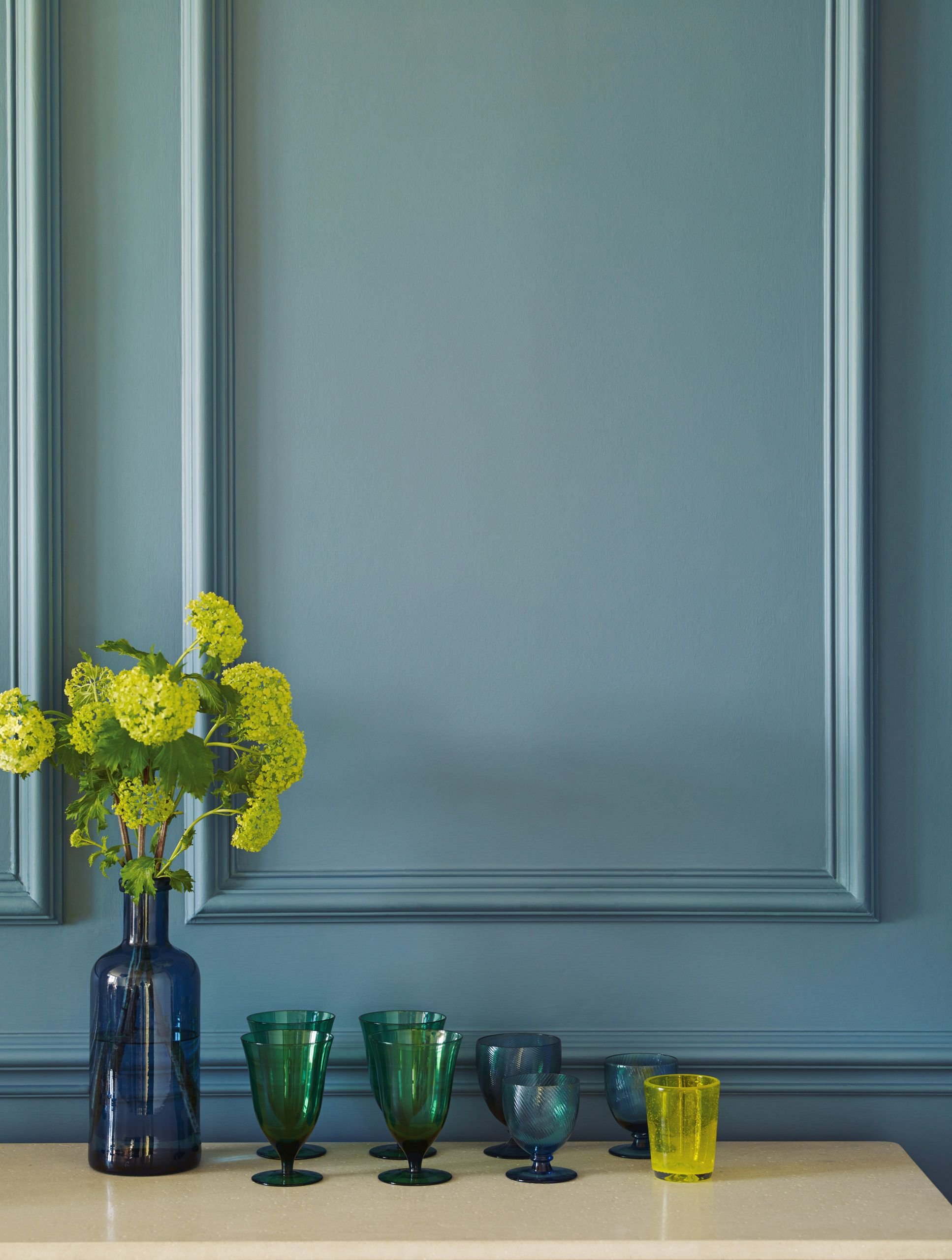Colour blue: is it a safe bet for business branding?
Written by Simon Cox
Simon in the blue and Rach in the cream modelling for our article on blue for business branding
Blue is the world’s favourite colour: across cultures and continents, blue comes top. It’s a colour we all engage with every day; it’s the colour of the sky and the seas around us. While it’s not a colour we see through trees and plants (there are relatively few true blue plants and no naturally occurring blue foods), it’s been used throughout human history in art and cultural ceremonies.
I had a conversation with my youngest daughter who has a favourite way of beginning a conversation: “Mummy, I have a question”. Her question on this occasion was: “Why are emergency service flashing lights blue?”. My initial thought was to do with its brightness and we don’t use blue in traffic lights. Actually, it’s because blue is the most visible colour at night. In part, I think there’s a secondary element: blue is a colour that tends to evoke feelings of stability and reliability. Key feelings when we’re in a crisis and might need help.
As part of our ongoing series on the Anatomy of Colour, we’re looking at how small businesses can harness the power of blue in their branding. Equally, we’ll help you avoid falling into the trap of boring blue: the go-to colour for soulless corporate branding!
This series on colour psychology for businesses and their branding is adapted from Kassia St Clair’s excellent book, ‘The Secret Lives of Colour’. (The beautiful, sought-after hardback version is well worth getting hold of!). The best places to buy ‘The Secret Lives of Colour’ are direct from the publisher, from your local independent bookseller, from bookshop.org or – as a last resort – from Amazon. Although Amazon is cheaper and more convenient, it is not a force for good in the world of books. Please support writers, publishers and small businesses directly if you can.
Wildings is a design agency in Devon. Our studio is based in Torquay, South Devon, and we provide branding for creative, hospitality and lifestyle businesses across Devon and the UK (like garden designers, interior designers, architects, floral designers). In this series, we’re looking at the power of colour in branding for small businesses, and this one is all about the colour blue. We want to help you harness the amazing characteristics of colour to maximise your small business brand: catch up on the previous article, ‘3 reasons to use the colour green confidently in your branding’ or explore the rest of our series on Colour Psychology for business brands →
Why does the colour blue have a cult following?
Blue has a long venerable past, which explains its popularity today.
The ancient Egyptians created beautiful opaque blue glass in their quest to recreate objects that resembled turquoise. Lapis Lazuli was valued for its rarity and vivid colour: it can only be found in a small handful of mines in North East Afghanistan, and when ground into a powder it forms a striking ultramarine hue. It was frequently used in its ultramarine pigment to adorn walls in tombs, paintings, statues and woven textiles.
Elsewhere, blue was used to smother Mel Gibson in the classic film Braveheart - he played William Wallace, who led the Scottish uprising. While there’s no historical information about Wallace painting himself blue, Boudicca the leader of the Iceni tribe in East Anglia is reputed to have painted her face blue using woad. The Romans referred to these Ancient Britons as ‘Picts’, Latin for painted.
Woad was a natural dye from a vibrant yellow plant which, when fermented and couched and mixed with potash and urine, turned into a blue dye. For centuries cloth was dyed blue using this plant until the 1930s.
(It was also a brand name we considered when we renamed ourselves from The Apple Yard.)
“Classical writers described the Celts making themselves blue, either daubing it on before battle or tattooing it directly into the skin. It has even been suggested that the word Briton derives from a Celtic one meaning ‘painted people’.”
Get inspired by the colour blue
Why not enjoy the interactive moodboard below - click and move images around.
The moodboard sources and image attribution: colour blue inspiration pinboard on Pinterest →
Why is blue is the colour king of corporate branding?
Blue is a hugely popular colour in business, chosen by small businesses and multinational conglomerates the world over.
The reason for blue’s ongoing popularity is because of its ability to convey security, order and dependability. This is highly desirable for businesses that want to project those qualities: typically big corporate brands want to come across as safe and dependable, so it’s the obvious choice in their branding.
The flip side of this is that because blue is so prevalent in big businesses, it has picked up negative connotations from that association: boring, bland, risk-averse and soulless. This is not to discount blue in its entirety; the judicious use of blue can enhance your brand, which we’ll talk about below.
In practical usage, the colour blue has also been known to boost motivation while also promoting peace and focus.
For small businesses who want to communicate with clarity, the colour blue is a great choice. People typically perceive brands that use blue to great effect as competent and sincere (so don’t automatically discount it!).
How my branding can stand out when so many brands use the colour blue?
In case you’re tempted to throw blue out straight away, don’t! As a brand designer here at WiIdings Studio, I (Rach) often employ a subtle hue of blue in the background of many brand colour palettes.
The way to stand out when so many other business brands use blue is not to get rid of it completely but to think carefully about whether it reinforces your brand values or desired customer experience.
What feelings do you want your ideal customer to experience when they interact with your brand? What do you want to convey through your branding? If the colour blue evokes those feelings and associations, then deploy it carefully for maximum impact or as a strong supporting element in your branding.
Blue is quite rare in certain settings such as eye colour (only about 8% of the population worldwide have blue eyes) or the ultramarine pigment. By playing on some of these characteristics, you can deploy blue in an unusual or striking way.
To reiterate, don’t discount blue, but consider how you can use its valuable associations with trust, loyalty and integrity. For example, if you want to promote a fun, playful, frivolous brand, subtly incorporating blue in your branding can bring a hint of trust and dependability to proceedings.
I like to use blue tones alongside other hero colours, backing up more daring colours and having the blue to ground the palette and make it feel a bit more grown-up or serious if necessary!
Wedgwood, navy, woad and cobalt are just some of the hues of blue.
“There are many tones of blue from light sky blue through to midnight blue and the many tones in between such as powder blue, duck egg blue, sapphire, royal blue, cornflower blue, indigo, navy and teal, just to name a few. ”
Independent brands using the colour blue
There are lots of brands using blue, and we’ll use it in branding projects too where appropriate. Here are three brands using blue quite differently to draw out their various qualities!
Farm Soap Co
A botanical skincare and wellbeing brand in Dorset. Using traditional artisan methods, they make botanical soaps and natural skincare products are handmade in small batches on the Jurassic Coast in Dorset.
Edward Bulmer Paint
A specialist brand in eco-friendly paint and natural heritage paint colours. A plant-based paint company with ethical and environmental practices. Breathable, non-toxic paints which are truly beautiful and responsive to light.
The Newt in Somerset
A boutique hotel brand in Somerset. The Newt in Somerset is a country estate with magnificent woodland and gardens. Members are invited to dine and stay on the estate.
Final thoughts on blue for businesses and in branding
One blue to never use…
OK, this is a personal taste but I really, really hate the default blue used in hyperlinks on websites and comes as standard on all Microsoft word documents!





















































